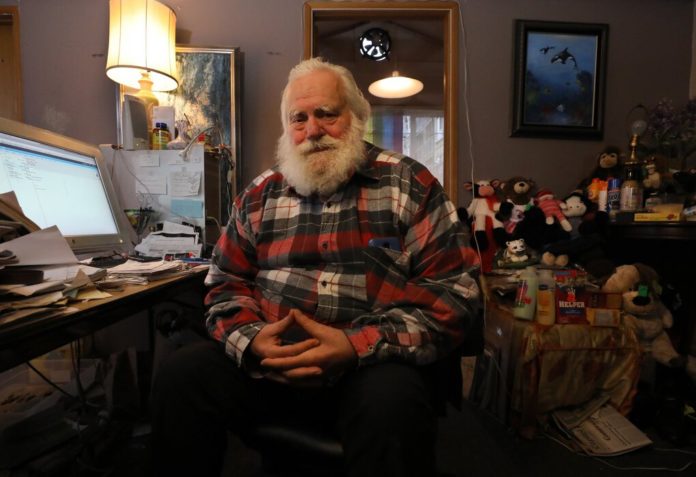When George Bakan, the editor and publisher of Seattle Gay News since 1982, died in June 2020, thousands of people in the LGBTQ+ community in Seattle grieved.
Bakan, known as “the Governor of Capitol Hill,” made the weekly newspaper Seattle’s leading source of information about the AIDS epidemic in the 1980s during a time when many news sources blamed gay people for the disease they called “gay cancer.” He also created a place where Seattle’s LGBTQ+ community could feel a sense of solidarity when many states still had laws in place against gay sex. (LGBTQ+ stands for lesbian, gay, bisexual, transgender and queer/questioning, with the + denoting everything along the gender and sexuality spectrum.)
“George and the SGN documented and witnessed our collective struggles and acknowledged our existence and humanity at a time that few wanted to see us,” says Fred Swanson, the executive director of Gay City, the long-standing Seattle LGBTQ+ resource center.

A devoted activist and leader in the LGBTQ+ community, Bakan over the decades grew the Seattle Gay News from a small community newsletter into a newspaper with a weekly circulation as high as 13,500.
But in the years leading up to his death, Bakan struggled with diabetes and heart disease, and the editorial quality and finances of the publication suffered, says his daughter, Angela Cragin, who inherited the publication upon her father’s death. And though the publication covered the LGBTQ+ community better than any other publication in Seattle, Bakan’s staff was mainly gay, white men, says Renee Raketty, a transgender woman who was the managing editor of the publication from 2005 to 2007. She says this lack of diversity hurt the publication coverage of groups like the trans community.
Now the publication is striving to be more inclusive in its hiring and coverage while it continues to honor Bakan’s legacy by preserving archives of the publication. The business is also still recovering from the financial issues caused by the pandemic and Bakan’s health problems by updating its website and social media presence, and by increasing its young readership, says Cragin, the new publisher and owner of Seattle Gay News.
Diversifying coverage
A.V. Eichenbaum, who’s 26, bisexual and nonbinary, has been the acting editor-in-chief since March. They say a person with their gender identity and sexual orientation couldn’t be the editor of a paper without the activism of people like Bakan.
Eichenbaum, who uses they/them pronouns, grew up in Gilroy, California, and wrote for community college newspapers and freelanced before moving to Seattle in 2017. They started writing for Eastlake News, a quarterly neighborhood newsletter, in 2018. Last December, they joined Seattle Gay News as a reporter.
“I’m standing on the shoulders of giants,” Eichenbaum says. But they also say SGN wasn’t always representative of the full breadth of the LGBTQ+ community in Seattle, and their focus is now on “the voices that have been stepped on by the cisgender, white, gay community.”
Cragin is considering Eichenbaum for the permanent editor-in-chief role at Seattle Gay News but says she didn’t want to give a position so defined by her father to anyone so soon after his death.
Eichenbaum and Cragin recently rebranded the publication from “Seattle Gay News” to “SGN” and added a rainbow design next to the masthead to symbolize its inclusion of all segments of the LGBTQ+ community.
Raketty, who’s been writing for the SGN again since Bakan died, says she’s happy to see the changes happening at the publication. Raketty started reading SGN as a high schooler, when she’d play hooky to hang out with her boyfriend on Capitol Hill. She says SGN inspired her to start a gay-straight alliance at her high school in Bellevue. And when Raketty started writing for SGN in 2002, she says Bakan mentored and supported her when she transitioned.
But at the same time, she says SGN’s coverage of trans issues was spotty and Bakan was set in his ways. Raketty is happy that the new editor of the publication is nonbinary and bisexual and says she’s already seeing better coverage of the trans community. For example, one of SGN’s Pride issues this year features an essay by Filipino American Seattle drag queen Gaysha Starr about transitioning during the pandemic.
“I think you can’t lose when you have someone who is bisexual-nonbinary, who represents a new generation of hungry writers, leading a newspaper with an aspiration of representing every diverse segment of the community it represents,” Raketty says.

Tom Rasmussen, the first openly gay man elected to Seattle City Council and a longtime SGN reader, says SGN’s coverage of LGBTQ+ communities of color under Bakan was better than any other publication in Seattle. And Starr says Bakan was supportive of everybody in the LGBTQ+ community, regardless of race. That said, Starr says, most of the coverage in the 1980s and 1990s focused on cisgender gay and lesbian subjects who were mainly white.
Out of nine SGN staff members and 10 contributing writers who responded to a survey conducted for this story, three staff members identify as nonbinary and 11 identify as women, with three of those women being trans. Fourteen of the respondents identified as white or Caucasian.
Since Bakan died, Eichenbaum and Cragin have hired people who represent diverse segments of the LGBTQ+ community, with the goal of improving SGN’s coverage and diversifying the staff. New hires include two nonbinary people and six women, one of whom is trans. Three of the new hires are people of color.
Janice Athill was hired as a contributing writer in January and writes a weekly article normally focused on Black issues. She says Cragin and Eichenbaum have been “extremely open-minded” of her story ideas and opinions and believes the paper is now doing an excellent job covering LGBTQ+ communities of color. Her first story was about societal discrimination against Black hair styles, and she recently wrote an article where she interviewed Brian Broome, a gay Black author, about his work.
Raketty says the staff is also younger than during Bakan’s time, which she believes helps SGN speak to a younger generation — the readers who will keep the business afloat in the future. Currently, Cragin says the readership is mainly white, gay men older than 45.
Starr says SGN is also staying current with the important issues in the LGBTQ+ community. In the 1980s and 1990s, that was the AIDS epidemic and lesbian and gay rights. In the 2000s, it was the marriage equality movement. Now, it’s gender identity and race.
Laying groundwork for future success

When Bakan died and left the publication to Cragin, the business was $100,000 in debt and on the brink of bankruptcy. Circulation was down to 1,000, mainly due to the pandemic. Advertising revenue was low.
Cragin says some staff members forgave debt for wages because they wanted the publication to survive. Other creditors never claimed their money. In the end, she was left with around $33,000 in debt that she’s paying off in installments. With the help of about $18,700 raised from an ongoing GoFundMe fundraiser, Cragin says the business can now pay its bills, but she says she’s not turning a profit nor paying herself for her work.
Cragin lives in the Tri-Cities and worked in child care and with special needs preschoolers before becoming publisher of SGN. She says she had a strained relationship with her father ever since he abruptly left her family to live as a gay man in Seattle in 1982, when she was 12. Cragin says her father adored her children and always cared about family, but she’s not sure why he left the publication to her, a straight woman who doesn’t live in Seattle.
When Cragin showed up in the newsroom a few days after Bakan died, grieving people she’d never met told her they had to save the publication for her father’s sake. Initially, she wanted to run away from the responsibility.
But the staff, dedicated even through their grief, kept putting out the paper. And Cragin heard from people like Raketty and photographer Nate Gowdy, who got his start at SGN, that Bakan had been a father and grandfather figure to them and others. She says hearing that he’d acted as a father to other people, if not always to her, lessened her grief and made her understand the importance of the publication.
“That’s where I felt like I really had to continue his legacy,” Cragin says. “I thought I should at least give it a try.”

To members of Seattle’s LGBTQ+ community such as Rasmussen, part of preserving this legacy meant preserving the archives of past editions of SGN.
Marcellus Turner, then the executive director of the Seattle Public Library system, reached out to SGN shortly after Bakan’s death to see what would be done with the archives. Turner created a team including Rasmussen to go through messy piles of old papers, drive truckloads to Seattle Municipal Archives and create complete sets of the paper to serve as a historical record.
Rasmussen says he volunteered for the project because LGBTQ+ history is often overlooked or misrepresented, and that SGN is the “best chronicle of the LGBTQ+ life that exists” in Seattle.
“This transformation could not have happened without the passing of George Bakan,” Raketty says. “I’ve never been more excited about the future of SGN than I am right now.”
Rasmussen says there are around 10 complete sets of the paper now, and they will be shipped near the end of the month to the library at Yale University, Seattle Public Library and Washington State Library, among other places. He says the Library of Congress requested issues that covered important events in LGBTQ+ history.
Looking forward, Cragin says SGN is getting more advertisers and may become profitable by the end of the summer. She says circulation is around 1,500 but increases to 2,500 or 3,500 for Pride month. Gowdy says with other Seattle publications like The Stranger no longer printing, SGN has the potential to grow. And Raketty says the paper’s focus on younger, more diverse writers will help it succeed.








